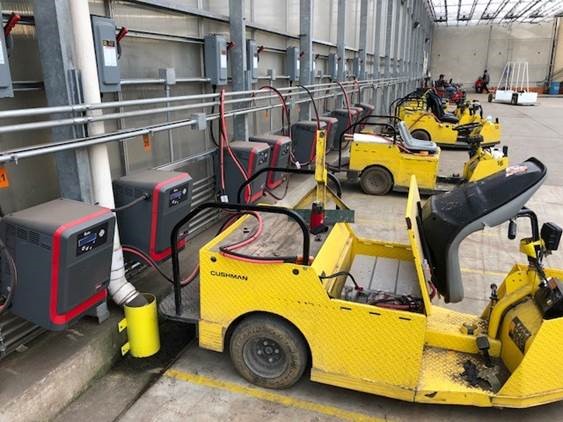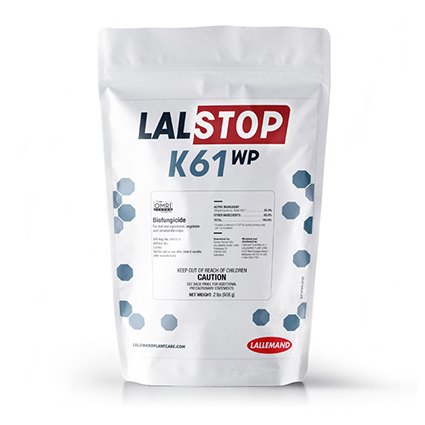New Battery Technology Helps Keep Greenhouse Production Moving

In early March of 2017, Green Circle Growers brought to the greenhouse floor a 48-volt Cushman tug outfitted with one NexSys TPPL battery.
Every mid-March, Green Circle Growers in Oberlin, OH, hits peak activity in its 100 acres under glass. Staff and automated systems spring into high gear, starting a grueling cycle of setting plugs, cycling plants, and sending product out the door to several big-box retailers.
Also at this time, the company’s fleet of more than 80 Cushman tugs start falling behind the production surge. More specifically, the conventional lead acid batteries powering the tugs can’t handle the increased charging and changing requirements.
Green Circle Growers’ Facilities Maintenance Manager Mark Sheldon calls the situation “a little nightmare, with 50 to 60 tugs looking for a charged battery, but only 15 to 20 charged battery packs available.” It delivers an immediate hit to the bottom line, as stationary tugs can’t move cycling plants or product to market. The situation takes a toll on the batteries, too, as many fail in just one to two years, driving battery replacement costs.
As Drew Hutzel, a longtime sales representative from Baker Vehicle Systems summarizes: “They had a battery problem.”
The Battery Issue Behind the Spring Back-Up
Green Circle Growers had been using a conventional lead acid battery and charger system that requires eight hours of charging to optimize battery uptime and lifecycle. For many demanding applications, conventional lead acid batteries can be the most cost-effective solution, but their longer charge times mean they are generally not the best fit for multi-shift operations.
This was the case at Green Circle Growers, where every spring, a vicious cycle of undercharging and overworking the flooded lead acid battery fleet resulted in diminishing battery power and life, and inevitably, tug downtime.
This costly situation isn’t uncommon for many greenhouses. Issues like chronic undercharging may mean it’s time for the facility to reassess its charger and battery power requirements with its suppliers. Even modest battery and charger upgrades can help boost fleet uptime and control Total Cost of Ownership.
Discovering TPPL Technology
When Hutzel found out about Thin Plate Pure Lead (TPPL) technology from EnerSys, he thought it sounded like an optimal solution to the Green Circle Growers’ battery bottleneck. He asked the greenhouse management team to take a close look at the technology.
Working with Hutzel, EnerSys Senior Technical Sales Representative Chuck Urso tailored a TPPL battery and charger solution that would provide fully charged batteries in just 1.5 hours and partially charged batteries in up to 45 minutes. It would also eliminate battery changeouts, watering, and weekly equalizations.
The productivity implications were intriguing enough that Green Circle Growers management asked Hutzel and Urso for a TPPL demonstration. In early March of 2017, they brought one to the greenhouse floor in the form of a 48-volt Cushman tug outfitted with one NexSys TPPL battery. After putting the tug and battery through its paces, Urso left instructions about how to opportunity charge the battery using the charger provided, which Green Circle Growers could then use to conduct its own battery comparison trial.
Reflecting the company’s commitment to testing and implementing advanced greenhouse technologies, Green Circle Growers’ management began the trial that same afternoon and imposed strict parameters.
From March through June 2017, two operators shared one TPPL tug and one set of tug keys, first for two 10-hour shifts in early spring, then one 11-hour shift by late spring. Charging instructions were simple — just plug the batteries into the charger during designated breaks and lunches.
Operating alongside the rest of the tug fleet for the facility’s busiest two months, the TPPL battery and charger solution performed as promised. A cursory look at TPPL technology helps explain why this battery design is well suited to opportunity charging.
TPPL Battery Technology at Work
Although they are also a lead acid battery, TPPL batteries differ from conventional lead acid designs — flooded or Absorbed Glass Mat (AGM) — in chemistry and design.
Conventional lead acid batteries use a lead alloy, but TPPL batteries feature 99% pure lead positive and negative plates. The plates are much thinner than conventional plates, so more of them fit into the battery. More plates mean more power, and the sealed design means the battery is virtually maintenance-free, which eliminates watering, changing, and weekly equalization requirements.
For Green Circle Growers, the key feature was its extremely low internal impedance, which allows a very high rate of discharge and quick, efficient charge acceptance. A compatible charger with a fast charge algorithm competes the process, allowing TPPL batteries to charge up to four times faster than conventional AGM batteries.
The batteries come equipped with a Protection from Over-Discharge (POD) device that indicates, through blinking lights and audible beeps, when it’s time to recharge the battery. To further protect the company’s technology investment, Green Circle Growers management had EnerSys add an automatic creep mode that slows the tug to a crawl when the battery reaches 60% Depth of Discharge (DOD). Operators that somehow miss the POD warnings and trigger creep mode are forced to go (very slowly) into a charging time-out for at least 40 minutes.
Creep mode set at 60% DOD also helps the batteries reach their full performance lifecycle. In service since November 2017, the original 10 TPPL batteries and chargers appear on track to do so, having made it through a busy spring season and a harsh 18 months at work without issues.
“It’s been amazing so far,” Sheldon says.
Green Circle Growers management intends to continue swapping the battery fleet from conventional lead acid to TPPL technology gradually until battery bottlenecks, changing, watering, and equalizing are eliminated.









